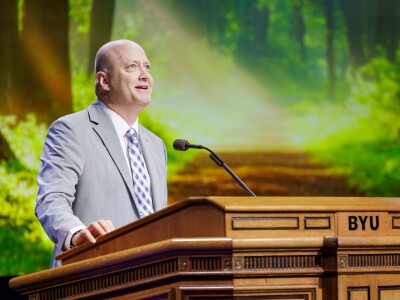Coaxing answers from 1500-year-old clues hidden in soil clumps, BYU environmental scientists identified a marketplace in an ancient Maya city, calling into question archaeologists' widely held belief that people of the era relied on rulers to tax and re-distribute goods, rather than trading them with one another.
As reported in the December issue of Latin American Antiquity, BYU professor of environmental science Richard Terry and his student team confirmed the location of a suspected marketplace on the Yucatan peninsula, giving Maya studies powerful new evidence for understanding the advanced civilization's economy.
Terry's specialty is analyzing soil from archaeological sites to find chemical traces that indicate what took place there. Such creative detective work is particularly useful in tropical areas, where 90 percent of inhabitants' possessions were made from organic material that has since decomposed.
"Looking at soil residues promises to open up the investigation of ancient Maya economic systems for the first time," said Bruce Dahlin, lead author on the new study and archaeologist with Shepherd University."It's the first way of confirming that an area that looks like a marketplace, is a marketplace."
In trying to determine if the Maya of the Classic era (about A.D. 300 to 900) had a market economy, scientists had found large, open areas within settlements of the period, but no indications of the areas' purposes. Terry's soil analysis revealed outlines of use clearly consistent with a modern-day open-air market in the region.
"These methods reveal intricate patterns of human behavior in what would ordinarily be invisible - the chemical residues left by trading, marketing, farming, and habitation," said Stephen Houston, a Maya scholar at Brown University not associated with the study. "[Terry] is at the forefront of developing and applying these methods in the New World."
Dahlin explained that he and other Maya archaeologists had recognized that many Maya cities appeared to have held more people than the regions' agricultural capacities could have supported. For years, researchers sought evidence of sophisticated farming or irrigation techniques to explain this. The idea of a market economy that facilitated the importing of food and other goods wasn't taken seriously, in part because it would be difficult to distinguish from most archaeologists' belief that the Maya elite had a tax and tribute system and effectively paid their underlings for loyalty by passing goods down the social ladder. But proof of the existence of a market would certainly prove a market economy.
After hearing a proposal from Terry's then-graduate student Chris Jensen, a coauthor on the new paper, Dahlin invited the BYU team to his dig in Chunchucmil on the western Yucatan. They sampled surface soil from a large, open area bordered by ancient thoroughfares, hunting for phosphorus.
"All food materials contain phosphorus, and a common denominator of all humans is that they bring food to places where they live," Terry said. "Over time, the organic matter is ground into the soil and rots, but the phosphorus holds to the soil particles even in a tropical rain forest that gets a meter or two of rain every year."
The soil chemists mixed two-gram samples of soil with chemicals and filtered the resulting solution. A handheld device shined light through the solution to determine the concentration of phosphorus.
"Our innovation was to develop a field laboratory so that we could report soil phosphorus results quickly to the archaeologists without having to wait for results from the Provo lab," Terry said.
The results from the plaza at Chunchucmil showed concentrations of phosphorus up to 40 times higher than in ancient patios and streets. The pattern of phosphorus residue indicated that a footpath ran through the marketplace parallel to the bordering street, and that food was vended on either side.
This layout proved to be consistent with the last remaining modern market in the region that runs atop soil (all the others have been paved). Another of Terry's students and coauthors, David Wright, sampled soil from that one, in Antigua, Guatemala, that yielded the similar pattern.
Jensen, who began his collaboration with Terry as an undergraduate, credits his research experience for his current success working at an environmental consulting firm.
"Dr. Terry provided me and a host of other undergraduates with many research opportunities that most students at other universities rarely get," he said. "Conducting research throughout Mesoamerica and then presenting papers on our findings was the chance of a lifetime."
The researchers believe further geochemical studies at other sites, such as the large settlements of Tikal and Chichen Itza, will reveal how far the market economy may have spread. Terry and his students are also analyzing other chemicals left in soil to pinpoint ancient workshops and religious sites and are studying carbon isotopes in the soil to locate the ancient corn fields.
Timothy Beach of Georgetown University is also a coauthor on the new paper. The research was funded by the National Science Foundation, the National Geographic Society, Howard University and BYU. The Instituto Nacional de Antropologia y Historia de Mexico allowed the work at Chunchucmil.
Writer: Marissa Ballantyne







